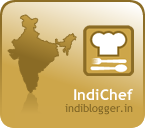
Things have changed since those good ol' days ...restaurants have mushroomed up in every nook and corner and everyone seems to be a master at cooking up everything ( why go far...I think so too :-D).
Chhole typically cooked with chickpeas or Bengal gram seem to be perfectly accompanied by Bhaturas or Kulchas. Strange, the name Bengal Gram, since the variety of chickpeas that we use to make chhole is a very new entrant to the Indian cuisine ( going by the ancient Indian Culinary History), making it's way through the mediterranean. The name was given kind courtesy the British, since they only found it in Bengal.
The word Chhole is synonmous with Punjab as is Bhangra. Punjabi cuisine has been known to be robust, thick and a fine balance of flavors. Erstwhile Punjab ( both in India & Pakistan) was divided into different regions from a cuisine point of view. So you had the rawalpindi region ( or Pindi for short), the Lahore and the Amritsari region among them, which explains the different versions of different dishes, Chhole being one of them.
I have over the last few years tried to figure out the differences between Pindi Chhole, Amritsari Chhole, Lahori Chhole & Chikkad Chhole. Most of the cookbooks, tend to give the same recipe, but a different name. This just adds to the frsutration of not knowing what have you actually ended up cooking. For starters, I still haven't unravelled this mystery completely.
As far as my know how takes me, Chikkad chhole & lahori chhole are the same. Chikkad in punju lingo means 'muddy'. In this dish the chanas are mashed in the cooking process, though not completely and the dish ends up looking as a muddy slush with some chanas still visible, though not in their perfect state.
Amritsari chhole are made with Kabuli chana, darkened with spices and with a nice thick gravy.
Pindi chhole ( pindi as they come from rawalpindi) are made with smaller chickpeas (not the Kabuli type), the gravy is dark and thick.
One thing though is common. They all have a tanginess thanks to anardana powder added to them, and a pronounced hint of cumin, thanks to the punjabi garam masala which has more cumin.
Then after all these varieties, is the one with a thinner and more gravy that is traditionally eaten with chawal (rice).
Ingredients:
Bengal Gram (Chana ) - 1 Cup
Black Cardamom (Moti Elaichi) - 2 No.s
Cinnamon (Dalchini) - 1" Stick
Bay Leaf (Tej Patta) - 2 No.s
Tea Bags - 2 No.s ( you can also use 2 cups of prepared black tea, strained)
Onion, Chopped Finely - 2 ( I prefer using a paste)
Tomato, Chopped - 2
Ginger Paste - 2 Tblsp
Green Chilli, Chopped Finely - 2 ( I just sliced them and put them in)
Garam Masala Powder- 2 Tsp
Corriander Powder (Dhania Powder) - 2 tsp
Red Chilli Powder - 1 tsp
Anardana (Pomegranate Seed) Powder - 1.5 Tsp
Salt To Taste
Oil - 100 ml
Method:
1. Soak Chana overnight ( or for 6-7 hrs) in water.
2. Drain and wash the chana in running water. Boil them alongwith black cardamom, cinnamon stick,bay leaves and tea bags ( or just add in the prepared tea) for 2 hours. (Better Pressure Cook for 30 mins).
3. Heat 4 tblsp oil in a separate cooking dish ( large enough to accomodate the chanas and gravy). Add Onions and saute for 5 mins on low flame. Add in the anardana powder and cook till onion paste turns golden brown. (Keep stirring to ensure you do not burn them).
4. Add ginger paste, tomatoes and chillies. Cook for another 3 minutes.
5. Add in the corriander powder, garam masala powder and red chilli powder. Cook till oil starts separating ( apporx. 5 mins)
6. Add in the chanas ( strain them and add them. reserve the liquid...Do NOT throw it away). Cook for 7-8 minutes.
7. Add in the strained liquid and salt. Cook till gravy thickens (approx. 15-20 mins).
8. Serve hot with onion rings, ginger julieenes and green chillies.

As you would have seen, cooking the chhole is not too difficult. Now we'll shift our attention to it's perfect accompaniment - Bhature.
Bhatura (Singular) is believed to have originated in Punjab and is a fried bread where the dough is allowed to ferment using yoghurt. Records from the erstwhile Mughal era state that Bhatura was a preffered bread for the Hindus who had it for breakfast alongwith sabzi (vegetable dish). Bhature can be plain or stuffed. The different stuffed varieties include aloo stuffed (stuffed with Potato mixture) & paneer ( stuffed with cottage cheese).
Ingredients:
White refined flour (Maida) - 4 Cups
Yoghurt (Soured) - 1 Cup
Salt -1 Tsp
Ghee (Clarified Butter) - 2 Tsp
Sugar - 1 Tsp
Baking soda - 1 Tsp
Warm Milk - 20 ml
Method:
1. Sieve the flour,baking soda and salt together.
2. Mix the ghee and the sugar with the flour.
3. Add the yogurt.

4. Add luke warm milk.
5. Knead well until the dough becomes soft and pliable.

6. Cover it with a wet cloth and keep aside for 2-3 hours.
7.Heat Oil in a wok (Kadhai) for deep frying.
9. Make small balls and roll them and fry in hot oil until golden brown.
10. Serve hot with Chhole.









 Sunday, October 14, 2007
Sunday, October 14, 2007
 Gaurav
Gaurav

 Posted in:
Posted in: 







0 comments:
Post a Comment